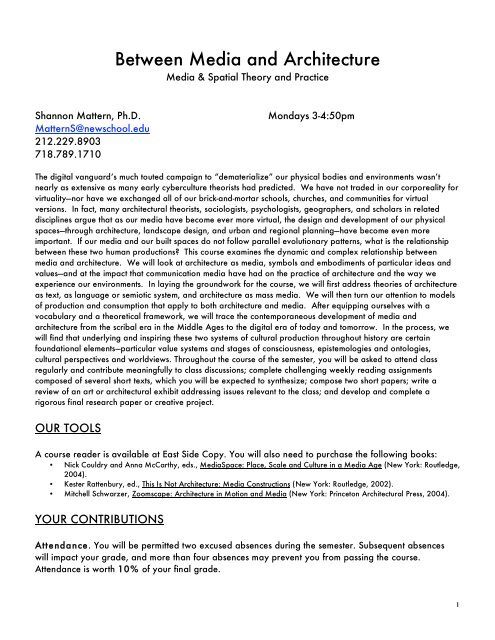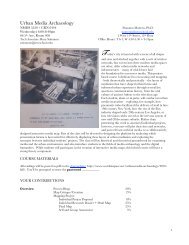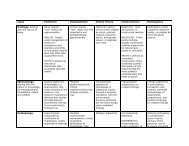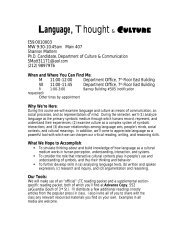Between Media and Architecture - Words in Space
Between Media and Architecture - Words in Space
Between Media and Architecture - Words in Space
You also want an ePaper? Increase the reach of your titles
YUMPU automatically turns print PDFs into web optimized ePapers that Google loves.
<strong>Between</strong> <strong>Media</strong> <strong>and</strong> <strong>Architecture</strong><br />
<strong>Media</strong> & Spatial Theory <strong>and</strong> Practice<br />
Shannon Mattern, Ph.D.<br />
MatternS@newschool.edu<br />
212.229.8903<br />
718.789.1710<br />
Mondays 3-4:50pm<br />
The digital vanguard’s much touted campaign to “dematerialize” our physical bodies <strong>and</strong> environments wasn’t<br />
nearly as extensive as many early cyberculture theorists had predicted. We have not traded <strong>in</strong> our corporeality for<br />
virtuality—nor have we exchanged all of our brick-<strong>and</strong>-mortar schools, churches, <strong>and</strong> communities for virtual<br />
versions. In fact, many architectural theorists, sociologists, psychologists, geographers, <strong>and</strong> scholars <strong>in</strong> related<br />
discipl<strong>in</strong>es argue that as our media have become ever more virtual, the design <strong>and</strong> development of our physical<br />
spaces—through architecture, l<strong>and</strong>scape design, <strong>and</strong> urban <strong>and</strong> regional plann<strong>in</strong>g—have become even more<br />
important. If our media <strong>and</strong> our built spaces do not follow parallel evolutionary patterns, what is the relationship<br />
between these two human productions? This course exam<strong>in</strong>es the dynamic <strong>and</strong> complex relationship between<br />
media <strong>and</strong> architecture. We will look at architecture as media, symbols <strong>and</strong> embodiments of particular ideas <strong>and</strong><br />
values—<strong>and</strong> at the impact that communication media have had on the practice of architecture <strong>and</strong> the way we<br />
experience our environments. In lay<strong>in</strong>g the groundwork for the course, we will first address theories of architecture<br />
as text, as language or semiotic system, <strong>and</strong> architecture as mass media. We will then turn our attention to models<br />
of production <strong>and</strong> consumption that apply to both architecture <strong>and</strong> media. After equipp<strong>in</strong>g ourselves with a<br />
vocabulary <strong>and</strong> a theoretical framework, we will trace the contemporaneous development of media <strong>and</strong><br />
architecture from the scribal era <strong>in</strong> the Middle Ages to the digital era of today <strong>and</strong> tomorrow. In the process, we<br />
will f<strong>in</strong>d that underly<strong>in</strong>g <strong>and</strong> <strong>in</strong>spir<strong>in</strong>g these two systems of cultural production throughout history are certa<strong>in</strong><br />
foundational elements—particular value systems <strong>and</strong> stages of consciousness, epistemologies <strong>and</strong> ontologies,<br />
cultural perspectives <strong>and</strong> worldviews. Throughout the course of the semester, you will be asked to attend class<br />
regularly <strong>and</strong> contribute mean<strong>in</strong>gfully to class discussions; complete challeng<strong>in</strong>g weekly read<strong>in</strong>g assignments<br />
composed of several short texts, which you will be expected to synthesize; compose two short papers; write a<br />
review of an art or architectural exhibit address<strong>in</strong>g issues relevant to the class; <strong>and</strong> develop <strong>and</strong> complete a<br />
rigorous f<strong>in</strong>al research paper or creative project.<br />
OUR TOOLS<br />
A course reader is available at East Side Copy. You will also need to purchase the follow<strong>in</strong>g books:<br />
• Nick Couldry <strong>and</strong> Anna McCarthy, eds., <strong>Media</strong><strong>Space</strong>: Place, Scale <strong>and</strong> Culture <strong>in</strong> a <strong>Media</strong> Age (New York: Routledge,<br />
2004).<br />
• Kester Rattenbury, ed., This Is Not <strong>Architecture</strong>: <strong>Media</strong> Constructions (New York: Routledge, 2002).<br />
• Mitchell Schwarzer, Zoomscape: <strong>Architecture</strong> <strong>in</strong> Motion <strong>and</strong> <strong>Media</strong> (New York: Pr<strong>in</strong>ceton Architectural Press, 2004).<br />
YOUR CONTRIBUTIONS<br />
Attendance. You will be permitted two excused absences dur<strong>in</strong>g the semester. Subsequent absences<br />
will impact your grade, <strong>and</strong> more than four absences may prevent you from pass<strong>in</strong>g the course.<br />
Attendance is worth 10% of your f<strong>in</strong>al grade.<br />
1
Participation. Because this class is a sem<strong>in</strong>ar, your thoughtful participation is essential to its success.<br />
You are encouraged to contribute—courteously <strong>and</strong> mean<strong>in</strong>gfully—to class discussions. Participation is<br />
worth 10% of your f<strong>in</strong>al grade.<br />
Read<strong>in</strong>g Responses. You have two options: you can either submit a total of ten 500-word<br />
(maximum!) read<strong>in</strong>g responses throughout the semester, or you can submit seven written read<strong>in</strong>g<br />
responses <strong>and</strong> one creative project, which is described below. The read<strong>in</strong>g responses are <strong>in</strong>tended<br />
both to help you to th<strong>in</strong>k collectively about each week’s read<strong>in</strong>gs – that is, to help you reflect on the<br />
selections you’ve read, to identify their similarities <strong>and</strong> differences <strong>and</strong> to appreciate their various ways<br />
of approach<strong>in</strong>g the week’s “theme,” <strong>and</strong> to use the <strong>in</strong>dividual texts’ arguments to piece together a larger<br />
underst<strong>and</strong><strong>in</strong>g of the relationships between media <strong>and</strong> space – <strong>and</strong> to help me guide each week’s class<br />
discussion. Please email me your responses <strong>in</strong> two formats: (1) as a Word/Word Perfect attachment to<br />
the email message, <strong>and</strong> (2) cut-<strong>and</strong>-pasted <strong>in</strong>to the body of the message by 10pm on the Sunday<br />
before each Monday class; late responses will not be accepted. The creative project is an opportunity for<br />
you to address the read<strong>in</strong>gs <strong>in</strong> any medium – on paper or canvas, <strong>in</strong> film, on video, <strong>in</strong> audio, etc. – <strong>and</strong><br />
to expla<strong>in</strong>, <strong>in</strong> a three- or four-page accompany<strong>in</strong>g text, what ideas you’ve grappled with <strong>in</strong> your work.<br />
The form <strong>and</strong> content of this creative production are entirely up to you, but I ask that you please submit<br />
an <strong>in</strong>formal proposal to me, <strong>and</strong> obta<strong>in</strong> my approval, before you beg<strong>in</strong> work on your project. The<br />
creative project can be turned <strong>in</strong> at any time, but must be submitted by the last day of class. These<br />
read<strong>in</strong>g responses – either <strong>in</strong> written or “project” form – are worth 35% of your f<strong>in</strong>al grade.<br />
Gallery/Event/Site Review. Throughout the semester New York will host several architecture-<strong>and</strong>media-themed<br />
exhibits <strong>in</strong> its museums <strong>and</strong> galleries. We’ll keep a runn<strong>in</strong>g list of relevant exhibits <strong>and</strong><br />
“sites to see” at www.words<strong>in</strong>space.net/board, <strong>and</strong> I encourage you to visit as many as you can.<br />
By the end of the semester, I’d like for you to submit a five- to six-page critique of one of those<br />
sites or exhibits. Please describe the site/exhibit, address the key theoretical issues the<br />
artist(s)/architect(s) is/are address<strong>in</strong>g, <strong>and</strong> assess his/her/their success <strong>in</strong> grappl<strong>in</strong>g with those issues.<br />
This review is worth 15% of your f<strong>in</strong>al grade.<br />
F<strong>in</strong>al Project. Throughout the semester, you will most likely come across several ideas, arenas,<br />
<strong>in</strong>dividuals, etc., about which or whom you would like to know more. This f<strong>in</strong>al project will give you the<br />
opportunity to delve deeply <strong>in</strong>to a research area of personal <strong>in</strong>terest. You should beg<strong>in</strong> th<strong>in</strong>k<strong>in</strong>g about<br />
potential topics immediately—but you must make sure to email me a one-paragraph proposal before<br />
Monday, April 18. This research project, which should be presented <strong>in</strong> a twelve- to fifteen-page<br />
paper, or a creative project with a five- to six-page accompany<strong>in</strong>g text, is worth 30% of your<br />
f<strong>in</strong>al grade.<br />
2
OUR SCHEDULE<br />
WEEK 2<br />
Monday, Jan. 31<br />
So…What Do <strong>Architecture</strong> <strong>and</strong> <strong>Media</strong> Have to Do with One Another?<br />
What do various media <strong>and</strong> architectural historians <strong>and</strong> theorists have to say about the<br />
relationships between media <strong>and</strong> architecture?<br />
Read<strong>in</strong>gs:<br />
Harold Innis, “The Problem of <strong>Space</strong>” In The Bias of Communication, pp. 124-131 (I’ve <strong>in</strong>cluded the entire<br />
chapter <strong>in</strong> the reader, <strong>and</strong> you may want to read it to provide context for the assigned excerpt).<br />
James Carey, Section V of “<strong>Space</strong>, Time, <strong>and</strong> Communication” In Communication as Culture, pp. 169-172.<br />
Adrian Forty, “Language Metaphors” In <strong>Words</strong> <strong>and</strong> Build<strong>in</strong>gs, pp. 62-85.<br />
Jonathan Hale, “Systems of Communication” In Build<strong>in</strong>g Ideas, pp. 131-170.<br />
Umberto Eco, “Function <strong>and</strong> Sign: The Semiotics of <strong>Architecture</strong>” In Neil Leach, Ed., Reth<strong>in</strong>k<strong>in</strong>g<br />
<strong>Architecture</strong>, pp. 181-201.<br />
Marshall McLuhan, “Hous<strong>in</strong>g” In Underst<strong>and</strong><strong>in</strong>g <strong>Media</strong>, pp. 123-130.<br />
Steven Heller, “Mak<strong>in</strong>g Build<strong>in</strong>gs Talk.” Metropolis (July 2002): 104-7, 165.<br />
Karrie Jacobs, “How Coney Isl<strong>and</strong> Is It?” Metropolis (October 2004): 74+.<br />
Philip Nobel, “The Futures of <strong>Architecture</strong>” Metropolis (January 2005): 58+.<br />
WEEK 3<br />
Monday, Feb. 7<br />
Inscrib<strong>in</strong>g <strong>Space</strong>: <strong>Architecture</strong> <strong>in</strong> the Scribal Era, <strong>Architecture</strong> as Inscription<br />
How was space designed <strong>and</strong> experienced <strong>in</strong> an oral, or aural, age <strong>and</strong> <strong>in</strong> a writ<strong>in</strong>g<br />
culture – <strong>in</strong> a time before the pr<strong>in</strong>t<strong>in</strong>g press, as many have argued, brought fixity <strong>and</strong><br />
l<strong>in</strong>earity to the word <strong>and</strong> the world?<br />
Read<strong>in</strong>gs:<br />
James Burke, “Communication <strong>in</strong> the Middle Ages” In Crowley & Heyer, Eds., Communication <strong>in</strong> History,<br />
pp. 80-89.<br />
Umberto Eco, excerpts from The Name of the Rose, pp. 34-39, 71-78.<br />
Steen Eiler Rasmussen, “Hear<strong>in</strong>g <strong>Architecture</strong>” In Experienc<strong>in</strong>g <strong>Architecture</strong>, pp. 224-237.<br />
Rob<strong>in</strong> Evans, “Translations from Draw<strong>in</strong>g to Build<strong>in</strong>g” In Translations from Draw<strong>in</strong>g to Build<strong>in</strong>g, pp. 152-<br />
193.<br />
Adrian Forty, “Language <strong>and</strong> Draw<strong>in</strong>g” In <strong>Words</strong> <strong>and</strong> Build<strong>in</strong>gs, pp. 28-41.<br />
Film: excerpts from The Name of the Rose<br />
WEEK 4<br />
Monday, Feb. 14 Talk<strong>in</strong>g Po<strong>in</strong>ts: The Stage <strong>and</strong> The Public Sphere<br />
What role does built space play <strong>in</strong> the construction of a public sphere, <strong>and</strong> how can space<br />
be designed to function most effectively as a performative space where people enact<br />
their roles --- as actors on the stage, as urban dwellers, <strong>and</strong> as democratic citizens?<br />
Read<strong>in</strong>gs:<br />
Sir Peter Hall, “The World as Stage” In Cities <strong>in</strong> Civilization, pp. 114-158.<br />
Jurgen Habermas, “Institutions of the Public Sphere” <strong>and</strong> “The Bourgeois Family <strong>and</strong> the Institutionalization<br />
of a Privateness Oriented to an Audience” In The Structural Transformation of the Public Sphere, pp.<br />
30-51.<br />
3
Jane Jacobs, “The Uses of Sidewalks: Contact” In The Death <strong>and</strong> Life of Great American Cities, pp. 55-73.<br />
Clive Barnett, “Neither Poison Nor Cure: <strong>Space</strong>, Scale <strong>and</strong> Public Life <strong>in</strong> <strong>Media</strong> Theory” In <strong>Media</strong><strong>Space</strong>,<br />
pp. 58-74.<br />
Films: excerpts from Ridicule, Barbershop, <strong>and</strong> The Social Life of Urban <strong>Space</strong>s<br />
WEEK 5<br />
Monday, Feb. 21 No Class: Presidents’ Day<br />
WEEK 6<br />
Monday, Feb. 28 “This Will Kill That”: Pr<strong>in</strong>t <strong>and</strong> Place<br />
How might we characterize the “architecture” of text, <strong>and</strong> how might pr<strong>in</strong>t’s “spatiality”<br />
affect the way we conceive of <strong>and</strong> design our built spaces?<br />
Read<strong>in</strong>gs:<br />
Walter Ong, “Pr<strong>in</strong>t, <strong>Space</strong>, <strong>and</strong> Closure” In Crowley & Heyer, Eds., Communication <strong>in</strong> History, pp. 114-<br />
124.<br />
Mario Carpo, excerpts from <strong>Architecture</strong> <strong>in</strong> the Age of Pr<strong>in</strong>t<strong>in</strong>g, pp. 1-56.<br />
Alan Powers, “The Architectural Book: Image <strong>and</strong> Accident” In This Is Not <strong>Architecture</strong>, pp. 157-173.<br />
Paul F<strong>in</strong>ch, “Architectural Publish<strong>in</strong>g: An Alphabetical Guide” In This Is Not <strong>Architecture</strong>, pp. 198-203.<br />
Films: excerpts from The Hunchback of Notre Dame, Ric Burns’ New York: A Documentary Film (Disc 2:<br />
“Order <strong>and</strong> Disorder”)<br />
WEEK 7<br />
Monday, March 7 Manufactur<strong>in</strong>g Desires: Plan Books, Packaged Design<br />
How did new commercial pr<strong>in</strong>t<strong>in</strong>g forms <strong>and</strong> formats <strong>in</strong>fluence the design of public <strong>and</strong><br />
private spaces?<br />
Read<strong>in</strong>gs:<br />
Gwendolyn Wright, “Populist Visions” In Moralism <strong>and</strong> the Model Home, pp. 9-45.<br />
Beatriz Colom<strong>in</strong>a, “<strong>Architecture</strong>production” In This Is Not <strong>Architecture</strong>, pp. 207-221.<br />
Beatriz Colom<strong>in</strong>a, “The <strong>Media</strong> House” In Assemblage 27 (August 1995), pp. 55-66.<br />
Neil Leach, “Wallpaper Person: Notes on the Behaviour of New Species” In This Is Not <strong>Architecture</strong>, pp.<br />
231-243.<br />
WEEK 8<br />
Monday, Mar. 14 Radio City: Wireless Technologies, Untethered <strong>Space</strong>s<br />
How did the divorce of communication from transportation (Carey) change the way people<br />
conceived of space?<br />
Read<strong>in</strong>gs:<br />
James W. Carey, “Technology <strong>and</strong> Ideology: The Case of the Telegraph” In Communication as Culture, pp.<br />
201-227.<br />
Stephen Kern, “Wireless World” In Crowley & Heyer, Eds., Communication <strong>in</strong> History, pp. 228-231.<br />
Susan Douglas, Broadcast<strong>in</strong>g Beg<strong>in</strong>s” In Crowley & Heyer, Eds., Communication <strong>in</strong> History, pp. 232-240.<br />
4
Jukka-Pekka Puro, “F<strong>in</strong>l<strong>and</strong>: A Mobile Culture” In James E. Katz <strong>and</strong> Moark Aakhus, Eds., Perpetual<br />
Contact: Mobile Communication, Private Talk, Public Performance, pp. 19-29.<br />
Leopold<strong>in</strong>a Fortunati, “Italy: Stereotypes, True <strong>and</strong> False” In James E. Katz <strong>and</strong> Moark Aakhus, Eds.,<br />
Perpetual Contact: Mobile Communication, Private Talk, Public Performance, pp. 42-62.<br />
Chantal de Gournay, “Pretense of Intimacy <strong>in</strong> France” In James E. Katz <strong>and</strong> Moark Aakhus, Eds., Perpetual<br />
Contact: Mobile Communication, Private Talk, Public Performance, pp. 193-205.<br />
Andrew Blum, “Cell Theory.” Metropolis (October 2001): 52.<br />
Film: excerpts from New York: A Documentary Film (Disc 4: “Cosmopolis”)<br />
WEEK 9<br />
Monday, Mar. 21 No Class: Spr<strong>in</strong>g Break<br />
WEEK 11<br />
Monday, Mar. 28 Collaps<strong>in</strong>g Dimensions: Photography <strong>and</strong> <strong>Space</strong><br />
How does photography render space, <strong>and</strong> what is photographic space?<br />
Read<strong>in</strong>gs:<br />
James S. Ackerman, “On the Orig<strong>in</strong>s of Architectural Photography” In This Is Not <strong>Architecture</strong>, pp. 26-35.<br />
Shelley Rice, “Introduction: Times Zones” <strong>and</strong> “Parisian Views” In Parisian Views, pp. 3-28.<br />
Mitchell Schwarzer, “Photography” In ZoomScape, pp. 165-205.<br />
Pierluigi Serra<strong>in</strong>o, “Fram<strong>in</strong>g Icons: Two Girls, Two Audiences / The Photograph<strong>in</strong>g of Case Study House<br />
#22” In This Is Not <strong>Architecture</strong>, pp. 127-135.<br />
Kester Rattenbury, “Iconic Pictures” In This Is Not <strong>Architecture</strong>, pp. 57-90 (mostly pictures).<br />
David Greene, “Foto-graph, Foto-shop” In This Is Not <strong>Architecture</strong>, pp. 121-124.<br />
WEEK 12<br />
Monday, Apr. 4<br />
Mise-en-Scene: C<strong>in</strong>ematic <strong>Space</strong>s<br />
How did particular places become centers of film production? How do movies construct<br />
filmic space, <strong>and</strong> how do we construct real spaces’ identities through their<br />
representation <strong>in</strong> film? How do we design spaces for the exhibition of film?<br />
Read<strong>in</strong>gs:<br />
Sir Peter Hall, “The Dream Factory: Los Angeles, 1910-1945” In Cities <strong>in</strong> Civilization, pp. 520-552.<br />
Douglas Gomery, “Nickelodeons to Movie Palaces” In Communication In History, pp. 201-206.<br />
Siegfried Kracauer, “Cult of Distraction: On Berl<strong>in</strong>’s Picture Palaces” In The Mass Ornament: Weimar<br />
Essays, pp. 323-328.<br />
Patrick Keiller, “Architectural C<strong>in</strong>ematography” In This Is Not <strong>Architecture</strong>, pp. 37-44.<br />
Anthony Vidler, “The Explosion of <strong>Space</strong>: <strong>Architecture</strong> <strong>and</strong> the Filmic Imag<strong>in</strong>ary” In Dietrich Neumann, Ed.,<br />
Film <strong>Architecture</strong>: Set Designs from Metropolis to Blade Runner, pp. 13-25.<br />
Dietrich Neumann, “Before <strong>and</strong> After Metropolis: Film <strong>and</strong> <strong>Architecture</strong> <strong>in</strong> Search of the Modern City” In<br />
Dietrich Neumann, Ed., Film <strong>Architecture</strong>: Set Designs from Metropolis to Blade Runner, pp. 33-38.<br />
Donald Albrecht: “New York, Olde York: The Rise <strong>and</strong> Fall of a Celluloid City” In Dietrich Neumann, Ed.,<br />
Film <strong>Architecture</strong>: Set Designs from Metropolis to Blade Runner, pp. 39-43.<br />
Michael Webb, “’Like Today, Only More So’: The Credible Dystopia of Blade Runner” In Dietrich<br />
Neumann, Ed., Film <strong>Architecture</strong>: Set Designs from Metropolis to Blade Runner, pp. 44-47.<br />
Films: excerpts from Playtime, Metropolis, <strong>and</strong> Blade Runner<br />
5
WEEK 13<br />
Monday, April 11 Boxed In: Televisual <strong>Space</strong>s<br />
How has television altered our perception of global space <strong>and</strong> domestic space, <strong>and</strong> how<br />
has it <strong>in</strong>fluenced the way we design our private <strong>and</strong> public spaces?<br />
Read<strong>in</strong>gs:<br />
SKIM Joshua Meyrowitz, “The Merg<strong>in</strong>g of Public Spheres” <strong>and</strong> “The Separation of Social Place from<br />
Physical Place” In No Sense of Place, pp. 73-125.<br />
Lynn Spigel, “The Home Theater” In Make Room for TV, pp. 99-135.<br />
Anna McCarthy, “Television at the Po<strong>in</strong>t of Purchase” In Ambient Television: Visual Culture <strong>and</strong> Public<br />
<strong>Space</strong>, pp. 155-93.<br />
Terence Riley, “The Un-Private House” In The Un-Private House, pp. 9-17, 22-25.<br />
Sanford Kw<strong>in</strong>ter & Daniela Fabricus, “Television: The Infrastructural Revolution” In Mutations, pp. 508-523.<br />
Films: excerpts from Brazil <strong>and</strong> The Truman Show<br />
WEEK 14<br />
Monday, April 18 Public <strong>and</strong> Private Exhibition <strong>Space</strong>s: C<strong>in</strong>ematic <strong>and</strong> Televisual <strong>Space</strong>s,<br />
Cont<strong>in</strong>ued<br />
Read<strong>in</strong>gs:<br />
Mitchell Schwartzer, “Film” In ZoomScape, pp. 206-253.<br />
Mitchell Schwartzer, “Television” In ZoomScape, pp. 254-305.<br />
WEEK 15<br />
Monday, April 25 Interfaces, Digital Places, <strong>and</strong> Other Networked <strong>Space</strong>s<br />
What has happened to our conceptions of space <strong>in</strong> an era of dematerialization <strong>and</strong><br />
decentralization? How have digital technologies changed the way we design our<br />
build<strong>in</strong>gs <strong>and</strong> cities, <strong>and</strong> altered our experiences of those built spaces?<br />
Read<strong>in</strong>gs:<br />
Lisa Parks, “K<strong>in</strong>etic Screens: Epistemologies of Movement at the Interface” In <strong>Media</strong><strong>Space</strong>, pp. 37-57.<br />
Mark Andrejevic, “The Webcam Culture <strong>and</strong> the Digital Enclosure” In <strong>Media</strong><strong>Space</strong>, pp. 193-208.<br />
James Hay <strong>and</strong> Jeremy Packer, “Cross<strong>in</strong>g the <strong>Media</strong>(-n): Auto-mobility, the Transported Self <strong>and</strong><br />
Technologies of Freedom” In <strong>Media</strong><strong>Space</strong>, pp. 209-232.<br />
Nit<strong>in</strong> Govil, “Someth<strong>in</strong>g Spatial <strong>in</strong> the Air: In-flight Enterta<strong>in</strong>ment <strong>and</strong> the Topographies of Modern Air<br />
Travel” In <strong>Media</strong><strong>Space</strong>, pp. 233-252.<br />
Fiona Allon, “An Ontology of Everyday Control: <strong>Space</strong>, <strong>Media</strong> Flows <strong>and</strong> ‘Smart’ Liv<strong>in</strong>g <strong>in</strong> the Absolute<br />
Present” In <strong>Media</strong><strong>Space</strong>, pp. 253-274.<br />
6
WEEK 16<br />
Monday, May 2<br />
Interfaces, Digital Places, <strong>and</strong> Other Networked <strong>Space</strong>s, Cont<strong>in</strong>ued<br />
Michael Bull, “’To Each Their Own Bubble’: Mobile <strong>Space</strong>s of Sound <strong>in</strong> the City” In <strong>Media</strong><strong>Space</strong>, pp. 275-<br />
293.<br />
Mitchell L. Moss <strong>and</strong> Anthony M. Townsend, “How Telecommunications Systems are Transform<strong>in</strong>g Urban<br />
<strong>Space</strong>s” In Cities <strong>in</strong> the Telecommunications Age, pp. 31-41.<br />
Andrew Ross, “Dot.com Urbanism” In <strong>Media</strong><strong>Space</strong>, pp. 145-162.<br />
Constant<strong>in</strong> Petcon, “<strong>Media</strong>-polis / <strong>Media</strong>-city” In Neil Leach, Ed., The Hieroglyphics of <strong>Space</strong>, p. 281-288.<br />
William J. Mitchell, “The Revenge of Place” In This Is Not <strong>Architecture</strong>, pp. 45-53<br />
**STRONGLY Recommended: Read William J. Mitchell, e-topia: “Urban Life, Jim—But Not as We Know It”<br />
Cambridge: The MIT Press, 1999; Visit <strong>and</strong> skim William Mitchell’s City of Bits:<br />
http://mitpress2.mit.edu/e-books/City_of_Bits<br />
Films: excerpts from The Matrix, M<strong>in</strong>ority Report<br />
WEEK 17<br />
Monday, May 9<br />
FINAL PAPER/PROJECT DUE<br />
7





